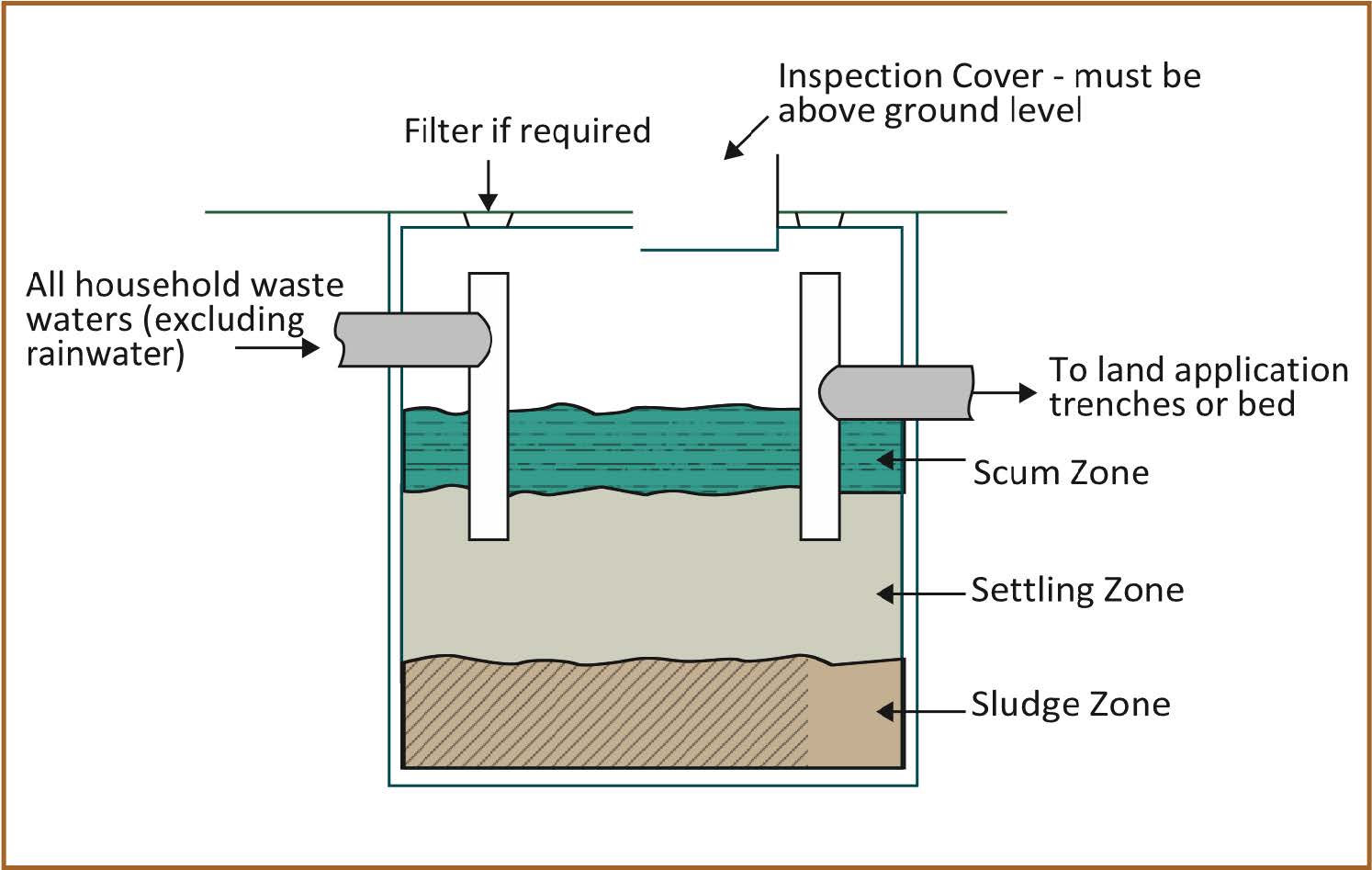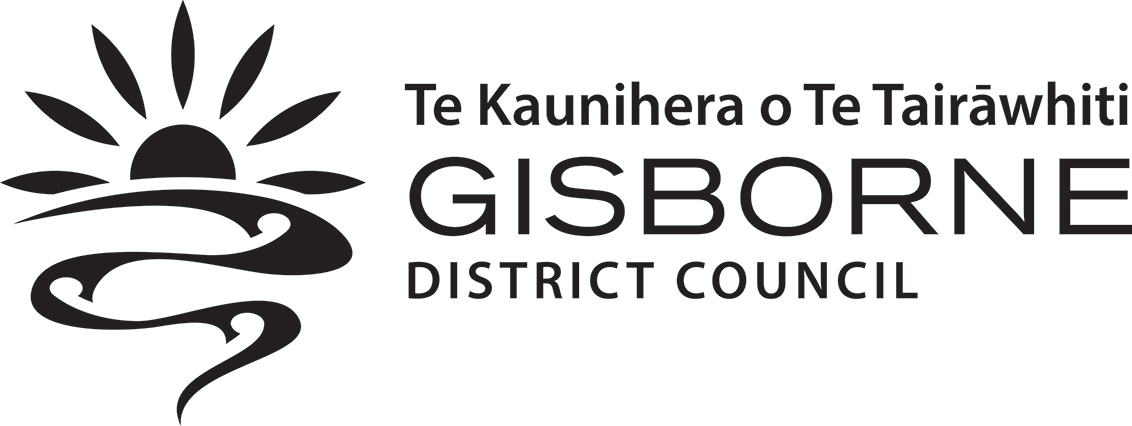Home wastewater systems are used on properties that aren't connected to a reticulated sewer network. In the Gisborne district, this includes houses in all areas outside Gisborne city, Te Karaka and Te Puia townships - such as Wainui Beach, Makaraka and surrounding rural and coastal areas.
When everything's working well, managing your own wastewater system is fairly straightforward. But if something goes wrong, it can be unpleasant - and costly to fix. Whether you're using or installing a septic tank, this information will guide you to do it right.
What are onsite wastewater systems?
Onsite wastewater systems - commonly referred to as septic tanks - are used to dispose of all household wastewater, including everything that goes down the drains or toilet.
With an onsite system, there’s no “flush and forget.” All your liquid household waste must be safely and hygienically processed on your property, within your wastewater system - which is a living system.
A well-functioning system contains and treats waste without contaminating groundwater or surface water and without harming the environment.
Types of systems
There are 2 main types of onsite wastewater systems:
- Septic tank systems - one or more tanks with a gravity-fed or pumped effluent disposal bed
- Home treatment system - usually with dripper line disposal.
Your wastewater system may include:
- Sanitary plumbing fixtures connected to drainpipes that carry sewage and sullage – that’s the liquid from kitchens, wash basins, toilets and laundries – to the septic tank.
- Treatment tanks – passive, aerated or filtered
- A distribution system - pump, siphon or gravity fed
- An effluent disposal system - trenches, beds, mounds or dripper lines.
How the system works
The type of onside wastewater system you install will depend on your property. Most systems work in a similar way: wastewater is gradually separated, treated and dispersed - with help from natural organisms.
Just like we have “good bugs” in our stomachs, septic tanks rely on anaerobic bacteria to partially break down solid waste. These organisms are essential for your system to function properly, which is why your septic tank must stay a chemical-free zone.
When you flush the toilet or run the tap, sewage and sullage flow into the septic tank. Solid matter settles at the bottom to form sludge, while fats and lighter materials float to the top and form a layer of scum.
The intermediate liquid — known as the settling zone — contains wastewater that has had most of its organic matter digested by the tank’s “bugs” (anaerobic bacteria).
This liquid is then discharged into an effluent dispersal system built into the ground, where it receives further treatment from organisms living in the drainage metal and surrounding soil.

An effluent trench or bed is dug deep enough for treated wastewater to safely soak into the ground - without contaminating groundwater.
- The trench or bed is lined with clean, washed river metal.
- A distribution pipe is laid flat within the metal.
- A textile filter cloth is placed over the metal before backfilling. This prevents soil from moving downward and clogging the drainage metal.
- The top of the trench system must be crowned to stop rainwater from pooling.
🚫 Important: Never dispose of chemicals - such as paint, disinfectant, petrol, flammable liquids or bleach - down your drains or toilets. These substances can wipe out the organisms your septic tank relies on to function properly.


Installing a wastewater system
If you’re installing a new onsite wastewater system, it’s important that the tanks and effluent dispersal areas are the right size - so they have the time and space to work efficiently.
Talk to a professional
A qualified wastewater professional can help you choose the best type of system and determine the right size and location for your property.
Site evaluation and design
Before you can get a building consent, your system will need a site-specific evaluation and design.
Consents for your wastewater system
Installing or upgrading an onsite wastewater system usually requires both building consent and resource consent. Here's what you need to know:
Building consent
Before a building consent can be issued, your system must undergo site evaluation and design. You’ll need to provide:
- A scale site plan.
- Details of the system type, size, and layout.
- Evidence that the design work was completed by a recognised wastewater engineer or approved assessor
Tip: The most important part of the evaluation is assessing your soil’s soakage capacity. Sand and gravels soak away quickly, while dense and thick clays may have little or no soakage.
A qualified assessor will design a system that suits your site - there are no shortcuts. A poorly designed system can fail, causing surface discharge, odours, health risks and environmental contamination.
Resource consent
Onsite wastewater systems must meet environmental standards under:
- The Resource Management Act
- Our Tairāwhiti Resource Management Plan
They must also comply with:
- The New Zealand Building Code
- The Building Act — including functional and durability requirements
Exempt work
Some like-for-like building maintenance projects may not require a building consent under exemptions in Schedule 1 of the Building Act. However, replacing a failed effluent line - even if it’s like-for-like - will likely still need a building consent.
Why? Because a failed system doesn’t meet the regional rules under the Tairāwhiti Resource Management Plan, so the exemption doesn’t apply.
Specialists and service agents
Some wastewater professionals carry out onsite assessment and design work specific to their brand of system. However, you can still use the information from your initial assessment to get quotes from a range of drainlayers.
You’re welcome to use any of the recognised wastewater site assessors and system designers listed below. Please note:
- The list is not comprehensive
- Council does not endorse specific products or services
- You may wish to seek other qualified providers.
| Web | Phone | Mobile | Address | ||
|---|---|---|---|---|---|
| Land Development & Exploration LDE | www.lde.co.nz | (06) 867 3035 | 027 4989 636 | info@lde.co.nz | 32 Grey St |
| Gary Thompson | (06) 867 7915 | 027 4410 895 | g.pthompson@xtra.co.nz | 176 Stanley Rd | |
| Terry Taylor Drainage | (06) 868 5383 | terrytaylor@xtra.co.nz | 89 Customhouse St | ||
| Alan Hall | (06) 862 5597 | 027 2724 907 | oaklandtruffle@xtra.co.nz | ||
| Carl Horne | (06) 868 1543 | 021 903 061 | carlandtech@xtra.co.nz | 834 Gladstone Rd | |
| WSP Consultants | (06) 868 5199 | 021 240 5541 | sarah.millar@wsp.com | ||
| Civil Projects Solutions | 0800 PROJECT | 021 471 289 | jacques.loiseau@civilprojects.co.nz |
The use of any firms or people listed does not constitute an official endorsement or approval by the Gisborne District Council of any product or service, that they provide or to the exclusion of others that may be suitable.
You may use your assessment to get quotes from a number of drainlayers and are in no way obliged to use the drainlayer who carried out the assessment.
Regular cleaning helps keep your wastewater system working efficiently and prevents costly problems. Some local agents offer septic tank cleaning services:
| Phone | |
|---|---|
| Wayne's Waste | (06) 867 3606 |
| Terry Taylor Drainage | (06) 868 5383 |
| Baywaste / Envirowaste | (06) 868 6007 |
| Chaffey's Waste Services Ltd | Ruatoria (06) 864 5865 |
| Septic Solutions Ltd | Te Araroa (06) 864 4831 |
| Fulton Hogan | (06) 869 1825 |
Several companies and agents in the Gisborne district offer maintenance services for domestic wastewater treatment systems.
| Type of wastewater system | Recommended servicing frequency | Agent contacts |
|---|---|---|
|
Bio-Cycle Oasis Clearwater |
6 monthly 6 monthly | Mark Varney M: 027 246 2715 W: thewatertankman.co.nz |
| Bio-Cycle | 6 monthly |
Thompson Drainage P: (06) 867 4902 M: 027 445 9720 E: thompsondrainage@xtra.co.nz |
|
Biolytix Aquablue Devan Blue |
Annually 6 monthly 6 monthly | |
| NaturalFlow | Annually |
Waterflow NZ Ltd P: 0800 628 356 E: sales@naturalflow.co.nz |
| Integra S-Series | 6 monthly |
Pauls Plumbing and Drainage P: (06) 863 3062 E: paulkor@slingshot.co.nz |
| KiwiTreat | 6 monthly |
KiwiTreat Limited Rangiora p; (03) 312 5787 |
| HYNDS Lifestyle | 6 monthly |
Terry Taylor Drainage P: (06) 868 5383 W; terrytaylor@xtra.co.nz |
| Innoflow - Advantex | Annually |
Walters Plumbing P: (06) 867 3065 W: waltersplumbing@xtra.co.nz |
| AirTech 9000 | 6 monthly |
Steve Wolters Plumbing M: 027 483 9663 P: (06) 868 8335 |
| Watercycle | Annually |
Brian Rofe Plumbing M: 0272 416 850 E: brofe@xtra.co.nz |
| Septech Turbo Jet 2000 | Annually |
Contact Council P: (06) 867 2049 |
| Gould Tanks | 6 monthly |
Contact Council P: (06) 867 2049 |
| Enviroflow | 6 monthly |
Ross Brown M: 021 081 0223 |
| General Servicing |
Brian Rofe Plumbing P: (06) 867 5292 M: 0272 416 850 E: brofe@xtra.co.nz |
Looking after your system
Regular maintenance helps your wastewater system run smoothly and prevents costly failures. Here's some key tips:
- Desludge every 3–5 years, or when scum and sludge fill two-thirds of the tank (or the first stage of a two-stage system)
- Protect your tank and absorption field from vehicles and heavy animals like cattle and horses.
- If you have a grease trap, clean it out regularly.
- Keep the vent and access cover of the septic tank exposed.
- Inspect and clean outlet filters if your system has one.
If things go wrong
A failed onsite wastewater system is a serious health and environmental hazard. It can lead to:
- Spread of infectious disease
- Increase in mosquitoes, flies and rodents
- Pollution of waterways, beaches, streams and shellfish beds
- Contamination of bores, wells and groundwater
- Air pollution and unpleasant odours
Regular cleaning and maintenance are essential to avoid these risks.
Costs to consider
Costs vary depending on the type of system, location and site conditions:
- Basic septic tank systems are generally more affordable than complex systems for sites with poor soakage or limited space
- Transport costs to remote areas can add significantly to installation and servicing fees
- Cleaning and servicing costs depend on your location - contractors often charge for time and mileage
- Systems installed since 2002 should have an outlet filter on the second tank or chamber - these must be cleaned regularly to prevent backups
- Systems with pumps, home treatment plants or low-pressure dosed effluent systems have ongoing power costs and may require bi-annual maintenance
Note: All maintenance is the homeowner’s responsibility.
Guides and information
No results found for ""
